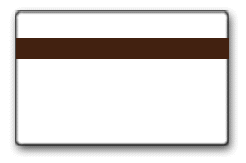Magnetic Stripe Encoding |
|||||||||||||||||||||||||||||||||||
Magnetic stripe encoding terms: Coercivity HiCo LoCo Selecting which type of magnetic stripe to adopt depends on how the card is to be used. Will the magnetic stripe be used daily, once a month, or just a couple of times a year? The chart below shows some of the applications where magnetic stripes are used and which stripe is common for that application. Typical Magnetic Stripe Card Applications, Types and Usage
The easiest way to determine visually if a stripe on a card is HiCo or LoCo is by the color. HiCo stripes are black and LoCo stripes are a lighter brown. Magnetic stripe readers are "blind" as to whether a stripe is HiCo or LoCo and are designed to read both. Another term often used is Stripe-up and Stripe-down. Stripe-up means the magnetic stripe is on the front of the card and Stripe-down means the magnetic stripe is on the back of the card. This information is important when ordering a printer since the magnetic encoder must be installed differently for Stripe-up and Stripe-down models at the factory. The most common is Stripe-down. All B&C Encoders follow the ISO standard for encoding, but can be changed via the encoder software to enable proprietary encoding. Proprietary encoding offers greater security and most readers can also be easily reprogrammed to read custom encoding. Go to Magnetic Card Writer page Go to Plastic Card Printer page Return to POS Peripherals main page
|
|||||||||||||||||||||||||||||||||||
